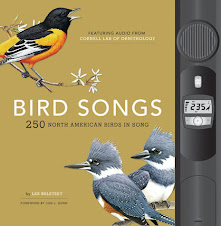
After school in the back yard, there was a male Northern Cardinal. I knew it was a male Northern Cardinal, because it had a tuft. I knew it was a male one because it was bright bright bright red. We see Northern Cardinals a whole lot in our yard, mostly in the front yard, but sometimes in the back yard, like today.
We also saw one at the bird barn. Since we saw one today, I want to write about the one we saw at the bird barn, too. I think it was a female. Maybe one will fly all the way to the Nature Center, or one will fly all the way to the back yard. And then, they'll mate!
Northern Cardinal
The Northern Cardinal's bill can open up an aluminum band that most birds are banded with. So, the bird banders put on a stainless steel band so that it stays on. The female is brownish with speckled red bill.
We already know what it sounds like but we found a sound for you anyway.
Here it is. We think this call sounds different than the Northern Cardinals in our yard and our book.
New facts that we learned while making this post:
It eats seeds and fruit and a little bit of insects.
They live in parts of the United States and in Mexico. They do not migrate.
Before we talk about warblers, we're going to talk about how they do stuff with the birds. This is how they get them back from the nets at the Nature Center. They bring medium and little bags made of fabric that close with a string and they put one bird in each bag. They bring them back in their cars to the bird barn and band them and do a lot of tests and let them out of the window or the door. Cause they have a trap door window in the bird barn. The top of the trap door opens, and then the bird comes out the top.
To identify the bird, first check on the bill to see how long it is for what kind of bird, then they check for the color to see what KIND of that kind of bird it would be, then they look the size. All of this will help you identify it.
More Warblers
Chestnut Sided Warbler
Like all warblers, it eats bugs. The one we saw was fully grown. It has reddish brown side wings, and a yellowish cap on top.

Facts we learned while making this post:
First we listened to the call. You can hear it
here.
It has a black mustache stripe on the face.
It breeds in Canada in summer.
It migrates down to Central America for winter.
Wilson's Warbler
We saw a female, but they told us that the male has a black cap on the head.
It has a greenish back and a bright yellow belly.
Facts we learned while making this post:
First we listened to the call.
Here it is.
This is a common bird. It breeds in Alaska and Canada in the summer. It migrates through the entire United States in the fall. And then! In the winter it is in Central America.

.jpg)

















